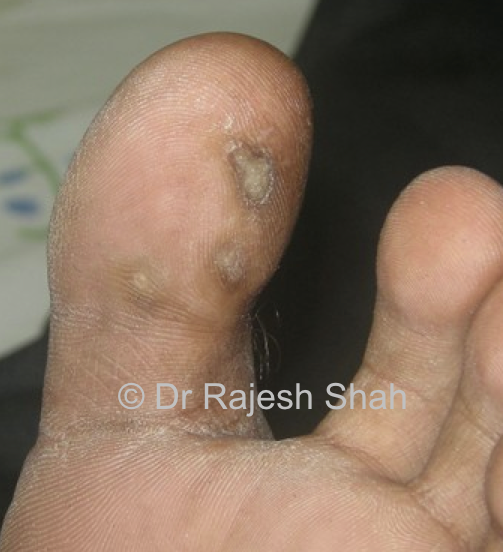 Homeopathy Treatment for Corns Callosities
Homeopathy Treatment for Corns Callosities
Callosities also known as clavus or corns, are toughened areas in the skin, as a result of repeated pressure or repeated contact with rough surfaces. They are most common on the hands and feet but appear localized to the area that bears repeated pressure or abrasion.
Cause of Callosities (Corns):
Corns and calluses arise from hyperkeratosis, a normal physiological response to chronic excessive pressure or friction on the skin.
The outermost layer of skin called the stratum corneum is maintained as a hard, protective, layer by the process of keratin deposition (keratinisation). The stratum corneum is thus maintained as a highly protective sheath over the skin. In hyperkeratosis, there is excess deposition of keratin over the skin as a result of repeated pressure or shear strain that chronically displaces or disrupts the stratum corneum. This excess deposition may happen either locally or in a diffuse manner depending upon individual tendencies and the nature of stresses involved.
Often, callosities are found in sensitive areas of the body where the overlying skin is exposed to repeated wear and tear. They are the body's natural response to repeated moderate and constant, pressures. Callosities are commoner over the skin overlying the weight-bearing areas of the body while the corns may appear on non-weight bearing areas of the palms and soles.
The corn is a localized collection of dead skin cells which have a very hard (indurated) center. Many clinicians believe that a typical callosity differs from a corn because its center unlike the corn is softer and not a hardened core.
Occasionally, when corns become painful, they are called 'bunions'.
The most common sites for clavus formation are the feet, specifically the dorsolateral aspect of the fifth toe for heloma durum, in the fourth interdigital web of the foot for heloma molle, and under the metatarsal heads for calluses.
Who gets a corn or callus?
Anyone who subjects their body parts repeatedly to pressures is candidates for corn or callus formations.
One's chances of developing corns or callosities increase if they are subject to the following conditions:
- Ill-fitting shoes.
- High-heeled shoes.
- Cramped footwear, use of hard footwear, using shoes without socks, etc.
- Foot deformities: bony projections or poorly united fractures, the presence of a second toe longer than the first toe.
- Dancing bare feet or wearing uncomfortable shoes.
- Playing musical instruments like the guitar, sitar, drums, etc.
- Writers are prone to developing callosities over the middle finger called 'a writer's bump'.
- Weight lifting can cause callosities in the palms of the person.
- Occupations like hair-dressers, carpentry, boxing, cherry pitting, dancers who perform spins on their backs, jewelry making etc. increase the occurrence of callosities on parts exposed to repeated frictions and pressures.
- Infants and children who suck their toes or fingers develop callosities over the areas of friction.
- Some medical conditions predispose a person to callosities. Callosities may form a part of their symptoms (keratoderma palmaris et plantaris) or natural squeal of the disease progression. Conditions that present with callosities at some point are:
- Diabetes -> chronic diabetes with peripheral neuropathy.
- Syphilis
- Rheumatoid arthritis -> abnormal pressure if there is a deformity of the foot.
- Diseases which affect nerves carrying sensations (sensory neuropathies)
- Obesity
- Bulimia nervosa
- Amputation
- Exposure to toxins like arsenic can cause hyperkeratosis of the palms and soles.
- Certain religious activities like offering prayers by kneeling with hands on forehead give rise to callosities on forehead called 'prayer calluses'.
Symptoms
- The affected area of the skin appears rough, thickened and hyperkeratotic.
- It is common to find the callus present with fungal infections.
- Pain: on applying direct pressure is not uncommon. Some callosities can be so painful that they seriously alter the person's gait and daily activities.
- Occasionally - the presence of a keratin plug in the center of the callus.
Diagnosis
Callosities can be diagnosed through proper descriptions of the symptoms, clinical examination, and histopathological reports of a biopsy specimen.
How long do Callosities last?
In most cases, the callus resolves once the offending pressures are removed. But, if they are caused by an underlying condition, there are high chances of recurrence.
Treatment for Callosities (Corn)
Any treatment measure opted for must treat not only the corn or callus but also provide relief from the underlying cause.
Callosities may be acutely painful because of the pressure of the central keratin plug on underlying nerves in the papillary (second layer of skin) layer. Callosities which are soft or overlying bony surfaces can occasionally become infected due to minor tears in the thin overlying skin.
- Pain relief can be obtained by paring the callus and relieving the tension within.
- Regular scrubbing with a pumice stone after soaking the feet or callus in warm water can prevent recurrence, especially in painless callosities.
- Uses of proper footwear which distributes weight evenly can prevent the recurrence of callosities.
- Adequate antibiotics or anti-fungal therapy will control the superadded infections.
Homeopathy for callosities
Callosities and corns show promising results with homeopathic treatment. Homeopathic medicines can relieve the pain as well as recurrence of the callosities. Painful callosities that cannot be scrubbed by pumice stones respond well to homeopathic medications taken internally.
- Case studies of Callosities (corns): Case 1, Case 2, Case 3,Case 4
- Related conditions: Warts
Written & Approved by-
Dr. Rajesh Shah
M.D. (Hom.)